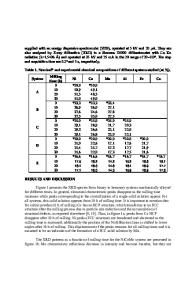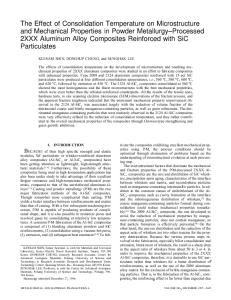Microstructural and Mechanical Properties of Cu-Based Co-Mo-Reinforced Composites Produced by the Powder Metallurgy Meth
- PDF / 3,739,400 Bytes
- 12 Pages / 593.972 x 792 pts Page_size
- 52 Downloads / 356 Views
JMEPEG https://doi.org/10.1007/s11665-020-05309-4
Microstructural and Mechanical Properties of Cu-Based Co-Mo-Reinforced Composites Produced by the Powder Metallurgy Method Emine Sap Submitted: 29 August 2020 / Revised: 13 October 2020 / Accepted: 24 October 2020 In this study, 5, 10 and 15 wt.% commercial purity Co-Mo powders are added to Cu powders using the powder metallurgy method. The prepared powder mixtures are shaped under a pressure of 600 MPa in a uniaxial hydraulic a press and then sintered at 1000 °C for 30 min. Scanning electron microscopy is applied for microstructural analysis. In the microstructure analysis, it is seen that as the reinforcement ratio increases, the grain sizes increase, and it is evenly distributed in Cu. A wear test is then carried out. As a result of this test, the weight loss, friction coefficient change and wear diameter change results of the composites are obtained. Abrasion loads are applied at 15, 20 and 25 N for 4000 m. The samples manufactured for the tensile test are subjected to certain loads on a Shimadzu tensile device. As a result of the abrasion and tensile tests, it was determined that the sample reinforced with 5 wt.% Co-Mo has the best mechanical properties. Keywords
cobalt, copper, mechanical properties, molybdenum
1. Introduction The continual development of technology results in a concomitant increase in the importance of studies in materials science and engineering (Ref 1, 2). Metal matrix composites are of particular importance in technology (Ref 3). Metal matrix composites can be referred to as composites consisting of metal elements such as Co, Fe, Cu and Al, with the main materials obtained by combining several products that are chemically and physically different (Ref 4-7). One of the production methods of these composites is the powder metallurgy (P/M) method (Ref 8). This method involves the process of producing a composite material that is formed by mixing P/M metal powders and compacting the mixture in a mould (Ref 2, 9, 10). The compacted parts take the form of moulds and are then sintered in a controlled atmosphere furnace for metallurgical bonding (Ref 11). An important advantage of P/M is that parts that are difficult to produce with different methods can be easily produced (Ref 12). With this method, material wastage is prevented and the rapid solidification of thin-scale dendritic structures during dust production leads to the development of mechanical properties (Ref 13-15). Despite its many advantages, P/M is less economical than some manufacturing methods due to the cost of powder production (Ref 16, 17). Copper and its alloys are widely used in many industries due to their excellent properties, such as conductivity, thermal
Emine Sap, Department of Mechatronics, Vocational School of Technical Sciences, University of Bingol, 12000 Bingol, Turkey. Contact e-mails: [email protected] and [email protected].
Journal of Materials Engineering and Performance
resistance and corrosion (Ref 18-21). It is known that Cu-Mo alloys are preferred in
Data Loading...











